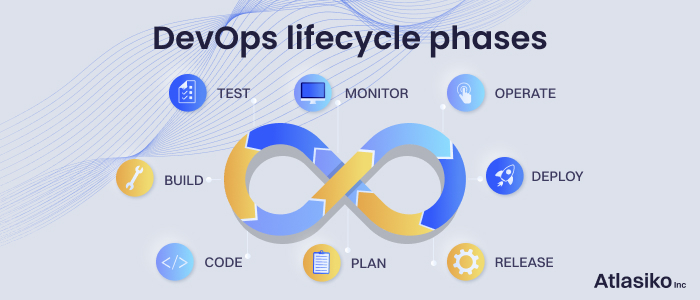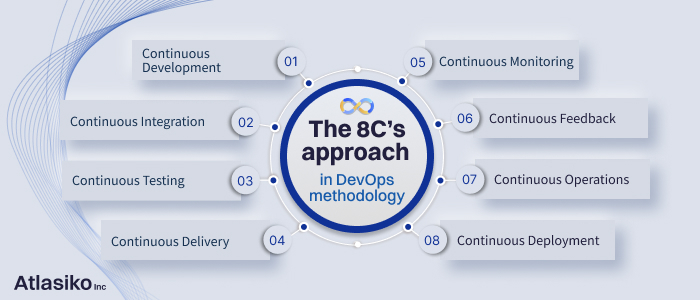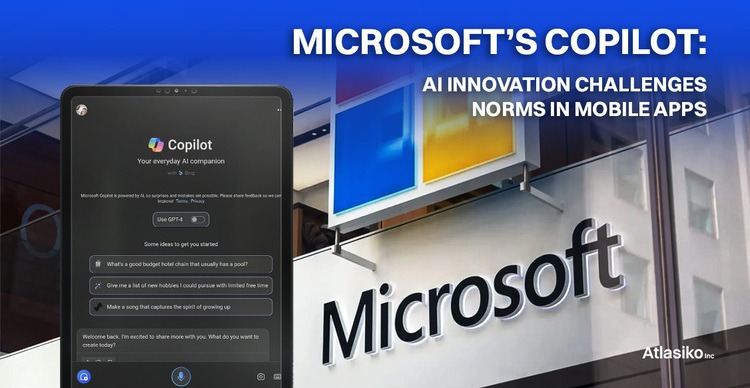Intro
DevOps is unquestionably one of the most favored approaches in contemporary software development practice. IT services firms implement the DevOps lifecycle in an effort to automate software engineering tasks, improve the speed, cost, and quality of IT product development, and enhance internal and external communication. This is one of the most effective strategies to undergo digital transformation. The application of this type of development cycles provides businesses with several advantages of DevOps, including process facilitation, an increase in productivity and profitability, and improved project structure.
The DevOps model has been a part of IT solution development at Atlasiko Inc. for a very long time, so we have a lot of experience setting up the DevOps process for other companies with our DevOps consulting services and using DevOps concepts for our own projects. Therefore, as an outcome of the software development services provided by our programming firm, you will receive high-quality applications and programs. We will define lifecycle of DevOps practice of software development, explain DevOps phases and highlight all distinctive characteristics of the DevOps software management lifecycle.
What is the DevOps lifecycle?
Before we dive into exploring the components of DevOps full lifecycle development, let’s give the definition of DevOps SDLC. If you want to know more about the DevOps methodology, read our article to find the answer to the question “What is DevOps?”.
The DevOps lifecycle is a process of IT solution development that includes the best practices in DevOps applied on all DevOps stages of software creation such as continuous software development, integration, testing, deployment, and monitoring. For the DevOps practice to be fully utilized, an efficient DevOps software lifecycle and the use of automated DevOps lifecycle tools are required.
In order to create, test, use, and improve software products, the DevOps approach supports continuous innovation, agility, and scalability. It encourages ongoing learning, experimenting, and feedback in order to deliver high-quality goods, services, and procedures. A thorough understanding of the DevOps lifecycle phases is essential for proper implementation, though.
DevOps lifecycle phases
Now let’s delve into a more detailed description of DevOps steps to find out all peculiar characteristics and qualities. It’s necessary to understand these SDLC DevOps stages for successful implementation of the DevOps organization of production processes and projects fulfillment. The following DevOps diagram represents the sequence of the application lifecycle stages.

- Plan
Project definition is taking place at this DevOps cycle stage. The expected functionality of upcoming software, the standards for each stage of development, and the effectiveness of the CI/CD lifecycle are all decided by the project team and the stakeholders together. It's a good idea to involve other teams in the planning stage, such as the marketing team, sys admins, tech writers, etc. The secret to successful project completion in DevOps planning is cooperation amongst all involved parties. - Code
Software engineers can begin the coding process once all functionalities that software needs have been decided upon during the planning stage of the DevOps lifecycle. It's crucial at this point for developers to adhere to the iteration principle, one of the key DevOps concepts, and use the appropriate DevOps lifecycle tools for CI to verify their code blocks in a centralized database. - Build
Development teams pull checked code from the centralized repository during this stage of the DevOps software development lifecycle using a specialized tool that automates the procedure. The program automatically moves code lines in a binary artifact, evaluates its performance, and posts the findings in the repository. - Test
Testing is a necessary component of DevOps workflow which cannot be completed without it. According to the DevOps continuous testing practice, all software components and parts must be rigorously examined. Developers employ automated tools for testing to speed up this process. Testing reports are another tool used by investors to learn more about the development cycles and gain insightful knowledge. - Release
The first element in the DevOps operations team's role in the deployment DevOps cycle is the release phase. In this, they handle change management, organize automated launches, and secure all necessary release permissions from stakeholders. - Deploy
The use of a continuous deployment lifecycle allows operations staff and developers to work together to automatically integrate all code changes. Deployment tools are used in DevOps deployment methodology to directly integrate these modifications into production, which affects the efficiency and speed of the software delivery process. - Operate
The DevOps operation stage entails IT administrators managing software development and DevOps production support. It comprises database and resource management, security assessment, infrastructure installation and maintenance, administration, and modification. Software development lifecycle tools that use infrastructure as code are used to complete all of these tasks. - Monitor
The DevOps support and maintenance SDLC components with some type of continuous monitoring tool form the continuous monitoring method used for DevOps management. Both the development and operations departments are engaged in this process to ensure that the finished DevOps product performs correctly and can be fixed quickly with the highest degree of automation possible.
Software Developer Operations divided between departments in DevOps Cycle
| Development Team | Operations Team |
|---|---|
| • Plan | • Release |
| • Code | • Deploy |
| • Build | • Operate |
| • Test | • Monitor |
As you can see, the responsibilities of software development and post-development operations are indeed divided. However, in the DevOps model, the collaboration between two teams is immense throughout the entire DevOps process which allows the successful creation and implementation of solutions without delays in timelines and extra spending.
How DevOps SDLC works in plain terms
For a better understanding of the processes that the DevOps lifecycle adheres to, it’d be convenient to take a look at some DevOps examples. All of the DevOps phases listed above are figuratively divided between development and operations teams. The first one is considered to be responsible for planning, coding, building, and testing IT products, and the latter carries out the release, deployment, operation, and monitoring.
As a brief DevOps example, let's say that the development team is working on an Ecommerce platform. They create this program, test it, and perform all necessary functional checks inside their office. Clients start utilizing the online solution as soon as the operations team makes it available and implements it in the company's IT infrastructure. Even though everything appeared to be perfect in the development environment, users start to complain that some functions won't work properly, such as when scheduled appointments are messed up due to overbooking, the app doesn't send patients reminders, the speed at which pages load is terrible, etc. Due to the poor quality of the developers' solution, the Ops team naturally has some complaints about them. Given that the web-based program performed brilliantly during testing and that the Ops team must have made a mistake when implementing the solution in the real world, the Dev team defends their work, which is only appropriate. Despite their disagreements with one another, they ended up with a useless product, a lot of wasted time, and a tarnished reputation.
The root of the problem is a chronic lack of communication between executive departments. If the Ops team had been included in the DevOps development process, programmers would have had access to information about the market and the actual demands of medical offices, and developers would have been quicker to implement such improvement suggestions by altering codes and features. In order to ensure success with project completion, the DevOps strategy presupposes that such constant cooperation starts right at the concept formulation stage.
Since Atlasiko Inc. follows all DevOps product standards when developing IT solutions, our Ecommerce platforms are consistently effective and interactive. Use our Ecommerce development services to expand your business's potential and competitive edge. You can also find out more about the DevOps process.

Even though some development projects might appear challenging, professionals of our team take it upon themselves to create an unparalleled solution. We develop programs keeping in mind business needs and goals of our clients.Talk to Expert
The 8C’s approach in DevOps methodology
Many helpful DevOps practices created over years of applying DevOps concepts in the software creation industry are included in the DevOps process. All of these developer operations and DevOps activities strive to increase efficiency, ensure automation and offer quick solutions to correct errors, and address difficulties in the software building workflows.
Continuous Development
Planning and coding for the product, that the team is creating, are part of the continuous software development phase of software lifecycle management. The project's description and goals are established during this stage of the Dev cycle, and developers begin writing code. As a principle of the continuous development approach, cooperation between the development and operations teams aids in task planning, defining objectives, and boosting team productivity.
Continuous Integration
This DevOps lifecycle process supposes the developers make several changes to the shared repository's source code rapidly after receiving testing results or feedback. Even minor modifications to a larger codebase are subject to testing and reporting. Continuous integration (CI) seeks to deliver prompt feedback, allowing for the speedy identification and correction of any flaws in software.
Continuous Testing
Continuous testing is necessary as one of the DevOps practices in order to obtain immediate feedback on the business risk associated with the release phase of the software delivery lifecycle. It is a challenging and important part of DevOps software development. Software test runs are easier to conduct continuously during all application lifecycle stages than to test an entire software product, hence automated testing methods are used. Such testing procedures help software engineers strike a balance between velocity and quality.
Continuous Delivery
Continuous delivery (CD) refers to the capacity to make changes, such as adding new traits and features, controlling configurations, resolving errors, and deploying experiments. Our motivation for choosing this practice for the solution delivery lifecycle is a daily upgrade that occurs continuously. Hence, we can quickly fix any mistakes that may have been introduced into the production code.
Continuous Deployment
Traditionally, continuous monitoring comes before the period of continuous deployment. However, developers make sure that this stage of the DevOps lifecycle is continually active, particularly when the app is released in masses and begins receiving heavy traffic. A crucial procedure of the DevOps deployment methodology is configuration management, which executes the correct deployment of application code across all servers. Updates are planned for all servers, code is distributed to them, and these configurations are maintained.
Continuous Monitoring
Every operational aspect of the DevOps automation lifecycle is involved in the monitoring phase, where crucial data about how the software is being used is meticulously examined to uncover patterns and pinpoint issue areas. The monitoring is typically part of the software application's operating capabilities. When it is in a continuous use position, it’s able to generate large amounts of data about the application parameters or manifest itself as documentation files. In this phase, the system errors, e.g. the server not being reachable and low memory, are fixed. It keeps the service's security and accessibility intact.
Continuous Feedback
The influence of each release on the user experience is assessed during the continuous feedback phase of the DevOps software release lifecycle, and the team is informed of the results in order to enhance subsequent releases. There are 2 major ways to collect feedback: structured and unstructured. Focus groups, polls, and interviews are used to implement the structured method. Through social media sites like Twitter, Facebook, and others, unstructured comment is gathered. Just like consumers review apps on Google Playstore, users here participate in this DevOps management by offering their input.
Continuous Operations
The goal of the continuous operations phase is to minimize planned downtime. Increasing the uptime, or the number of times users can use the application is the aim of the developer operations phase. Usually, in traditional software development operations, programmers have to take the production server offline in order to make modifications when they wish to upgrade it. This would result in more software downtime, which would cost the firm money.

Why use the DevOps cycle for software development
- The DevOps lifecycle is a helpful strategy that leads programmers and IT operations specialists through the difficult process of developing an app.
- Increased returns on investment (ROI) result from improved efficiencies.
- It is frequently used by both small and big teams, and it aids in lifecycle phase DevOps organization, alignment, and tracking.
- Early bug detection and correction are made possible by automatic monitoring, testing, and releases.
- DevOps engineers can better their code quality and learn more about their products thanks to a variety of automated ways for gathering input.
- It enhances organizational communication and teamwork. DevOps companies can explore and innovate rapidly when using DevOps concepts to produce a product. They become more trustworthy, which makes them even more adaptable.
- It boosts the effectiveness. It is essential to use IT automation lifecycle more often, and DevOps makes it simple to automate procedures. Automating repetitive chores frees up team members to work on more worthwhile projects. Automation lessens the possibility of human error.
- Shorter development periods and quicker innovation are the results. Applications are developed more quickly with a unified development and operations team. They are also more quickly prepared for the customer's use.
Waterfall vs Agile vs DevOps practices compared
The methods used in software development are always changing. Let's compare Waterfall, Agile, and DevOps processes of IT solution development to find the best method for your firm to deliver high-quality software.
Definition of the Waterfall methodology
System development traditionally follows a plan-driven process called Waterfall methodology. It is a technique of creating in successive stages and is one of the first software development lifecycle (SDLC) approaches: сompile and evaluate the software's performance standards before designing, creating, testing, and deploying it. A stage's output is necessary to start the following step.
Agile software development model
Agile software development methodologies have been utilized since the early 1990s and were developed in response to the need for quick product delivery. The Agile methodology enables the investigation of novel concepts and a more rapid evaluation of their viability. Agile development methodologies also have the flexibility to change with the demands of the business. Agile mostly employs the Scrum and Kanban paradigms. Iterations and speed are essential elements of Scrum, whereas the work-in-progress aspect of a Kanban is a core part.
Comparison with DevOps software creation processes
| Waterfall | Agile | DevOps |
|---|---|---|
| • The Waterfall technique depends on an exhaustive specification of the requirements. However, business requirements may alter throughout the course of development, disrupting the definition of the requirements, or they may be postponed until a later release. | • Rapid prototyping that takes needs as they evolve and develop is what the agile approach presupposes. However, the project manager is more accountable for jointly defining business needs. | • Small releases with regular updates and testing are part of the DevOps deployment technique, which makes the development cycle less risky. As a result, IT product development is simpler to oversee and more quickly corrects problems. |
| • The necessary technology, resources, and employees can all be planned out by project managers. Lack of any resource (such as a technology's performance or logistic delays) might cause the project to deviate from its track and miss its budget and/or timeline goals. | • Each development sprint is adjusted by project managers depending on the resource availability. But the variety in each sprint may make it harder to see the total project timetable. | • Small cycles of DevOps workflow are managed by specialized teams. DevOps work is considerably simpler to plan and arrange for frequent releases. You'll need to plan a week of development and operations rather than monthly planning. |
| • A significant public event is typically held in conjunction with the release of new software and the deployment of upgraded versions. However, there are numerous dangers associated with a single release because numerous problems could arise after implementation. | • Testing that is both continuous and automated keeps the development process concentrated on the main needs. Each sprint is followed by a review of the test plan. The testing team can easily participate in the specifications modification phase. Yet, in order to maintain testing relevant to the creation, resources for test management and automation are needed. | • The DevOps loop and automation tools allow devoted DevOps teams to gather and process data quickly and effectively. The results of the automated analysis can be used to improve the software. |
| • Testing is customized for each identified product module, however, it can be challenging to adjust tests to newly occurred releases and needs. After all, the work is finished, the test plan is looked over. | • The agile paradigm is not appropriate for small projects. When compared to other approaches, the costs associated with developing small projects utilizing agile are higher. | • The DevOps concept acknowledges the likelihood of bugs and issues upfront. It enables the quick development and execution of risk management plans. |
| • In smaller projects with clearly defined needs, the waterfall paradigm performs well. However, the waterfall technique is not appropriate for creating massive projects. | • Progress and overall success of the project are gauged according to built and deployed features in accordance with the budget limitations in the agile paradigm. | • A DevOps organization can evaluate expenditures, work capacity, and the amount of time spent on productive activities to determine the success of a project. Finding waste portions is simpler and quicker with the DevOps flow. |
| • In the waterfall methodology, finished and evaluated artifacts are typically used as a metric for success. | • Agile better coordination, self-organization, teamwork, and cooperation. This promotes general motivation and dedication to the objectives and results of a project. People might not know what to focus on while the scope is developing for teams who are new to working with Agile techniques. | • Software releases typically don't organize with elaborate ceremonies since DevOps delivery of IT products occurs regularly as a result of CI/CD DevOps solutions, automation, and reduced development cycles. Testing protocols are automatically set up for continuous updates. Companies only formally distribute software to the public when it has passed the trial phase. |
Brief DevOps implementation roadmap
It's best to think about implementing DevOps gradually as you strive toward success. You can choose to base your DevOps implementation on an agile strategy, depending on where your organization is at the present. The following would be an example of a gradual DevOps adoption order:
- Display the DevOps Initiative
The introduction of the DevOps effort depends on the organization's IT chief. DevOps supports other company operations like human resources and investment while being a component of the enterprise's IT activities. The IT director can therefore alter DevOps processes. The program manager then creates DevOps plans specific to the company's needs and oversees their execution. - Create a DevOps strategy
Program managers must establish a shared objective to bring teams together collaboratively. Each team member feels a sense of accountability and obligation as a result. DevOps relies heavily on software development lifecycle best practices that promote innovative approaches to software development, infrastructure, and testing while enhancing teamwork. Your strategy should focus on two objectives: helping the team as a whole do its work to the best of its ability, and assisting the continuous release of processes ready for production. - Use application containers
Software containerization is a quickly developing solution that is altering how cloud-based application instances are tested and run by programmers. Your programs become compact and simple to execute when you containerize them. As software is used, its stability is increased by container packaging. Furthermore, the software is autonomous of the extensive infrastructure thanks to its container components. This improves its ability to operate independently in any context. Furthermore, containerizing enables DevOps teams to quickly manage the software and make any adjustments required for a specific microservice. - Integrate CI/CD Tools with Infrastructure
Managing containers actively is necessary. Concerns about efficient change control and deployment can be addressed by combining infrastructure automation tools with CI/CD systems. By means of routine inspection and ongoing software changes, these tools prepare containers to take some risks. - Increase test automation and align QA and Dev
More test automation will result in shorter delivery cycles, better quality, and greater test management. This does not imply, nevertheless, that all tests must be automated. Determine how many iterations each test requires before automating any of them. By doing so, you'll be able to determine whether automating a test is actually worthwhile. The treatment of post-launch issues, however, depends on QA-Dev alignment. This alignment enables the early identification of mistakes and aids developers in resolving issues prior to the subsequent release. - Keep track of software performance
The DevOps team has awareness of problems that arise during the product life cycle thanks to program performance monitoring. Identifying application flaws, giving them priority, and determining their main causes are also helpful.
Conclusion
We hope that this article has explained the DevOps lifecycle in an uncomplicated manner. Knowing what the DevOps software development cycle means makes it simpler to recognize its beneficial impact on the development of apps and decide on DevOps implementation. Thanks to cutting-edge DevOps solutions, the DevOps paradigm boosts productivity and accelerates the introduction of new software or updated versions to the market.
Atlasiko Inc. successfully employs DevOps concepts. With Atlasiko's IT outsourcing services, you can safely provide your business with the resources and skills it needs to enhance its IT infrastructure and software quality.







